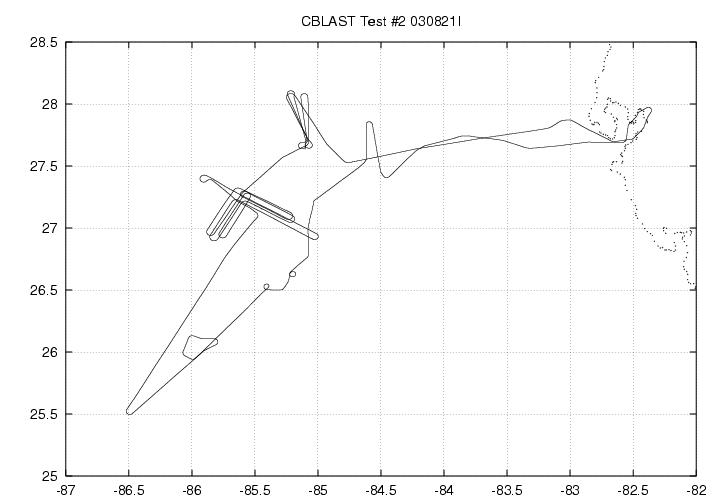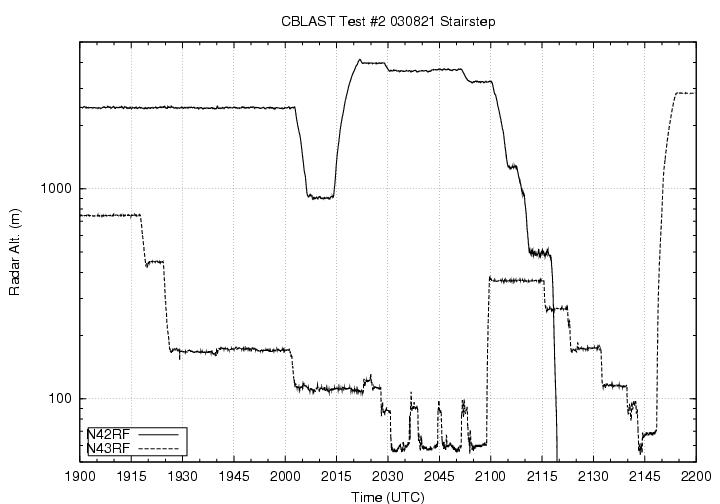Mission Summary
20030821I Aircraft 43RF
inter-comparison and calibration flight
between NOAA43/NOAA 42
Scientific Crew (43RF)
| Lead Project Scientists
| Rob Rogers
Michael Black
|
| Radar Scientists
| Eric Uhlhorn
Michael Black
|
| Dropwindsonde Scientist
| Michael Black
|
| AXBT Scientists | Eric Uhlhorn
|
| SRA Scientist | Ed Walsh
|
| BAT Probe Scientist | Jeff French
|
| CIP Probe Scientist | Chris Fairall
|
Mission briefing:
This flight was intended as a follow-on to the calibration flight of 19 August 2003. Some of the BAT probe calibration maneuvers were repeated today, such as the deceleration/acceleration and pitch maneuvers. After these were completed, the simulated mission was begun. Coordination was made with N42RF, and the simulated eyewall penetrated was performed at 2500 ft, with buoy 42003 intended to represent the center of the storm. An inbound leg was performed, heading of 225 degrees, and 2 AXBT’s and 1 GPS sonde were dropped. Continuing on same heading and after coordinating with N43RF again, an outbound leg was performed, with 2 BT’s and 1 sonde dropped again.
After the simulated eyewall penetration, 43 turned to a position NE of buoy to begin stepped-descent patterns. IP for stepped descent was chosen to be close to line of convection offshore from Tampa. First pattern was flown at 600 ft, and was designed to be in along-wind pattern. Leg continued for 20 n.mi., then 42 turned 180 degrees (turning to the right) and repeated leg at same altitude. After returning to IP, aircraft turned to left 90 degrees and performed a cross-wind leg of same distance. These patterns and turn directions were repeated for altitudes of 400 and 200 ft.
Mission summary and evaluation:
 Overall, the mission was a success. Takeoff time was at 170248 UTC from MacDill, flight duration was 5.5 h. AOC engineers and staff worked hard on 43RF to install and ground test Chris Fairall's CIP probe and backup pylon, the HRD SFMR and Ed Walsh's SRA, that still didn't work 100% at takeoff. Ed solved that problem half way through the flight, whereupon it began transmitting the required pulse. After that all CBLAST instruments on 43RF and the IWRAP on 42 RF functioned nearly flawlessly. The CIP, the LICOR, the SRA (after the smack), the BAT probe, the IRGA, the MASS downward camera, the laser altimeter, the sonobuoys and receiver, the AXBT's and receivers, the GPS sondes and system (complete with real time transmission), the HRD SFMR, the aircraft data system on both aircraft, the LF and TA Doppler radars on both aircraft, the IWRAP on 42. There are still some loose ends to tidy up like the primary CIP pylon (the backup system was used today), the down IR camera, etc. But after today, I think we can say we are CBLAST ready with the NOAA aircraft component.
Overall, the mission was a success. Takeoff time was at 170248 UTC from MacDill, flight duration was 5.5 h. AOC engineers and staff worked hard on 43RF to install and ground test Chris Fairall's CIP probe and backup pylon, the HRD SFMR and Ed Walsh's SRA, that still didn't work 100% at takeoff. Ed solved that problem half way through the flight, whereupon it began transmitting the required pulse. After that all CBLAST instruments on 43RF and the IWRAP on 42 RF functioned nearly flawlessly. The CIP, the LICOR, the SRA (after the smack), the BAT probe, the IRGA, the MASS downward camera, the laser altimeter, the sonobuoys and receiver, the AXBT's and receivers, the GPS sondes and system (complete with real time transmission), the HRD SFMR, the aircraft data system on both aircraft, the LF and TA Doppler radars on both aircraft, the IWRAP on 42. There are still some loose ends to tidy up like the primary CIP pylon (the backup system was used today), the down IR camera, etc. But after today, I think we can say we are CBLAST ready with the NOAA aircraft component.

Michael Black
Lead Project Scientist
Last Updated : August 26, 2003
Return to Mission page.
 Overall, the mission was a success. Takeoff time was at 170248 UTC from MacDill, flight duration was 5.5 h. AOC engineers and staff worked hard on 43RF to install and ground test Chris Fairall's CIP probe and backup pylon, the HRD SFMR and Ed Walsh's SRA, that still didn't work 100% at takeoff. Ed solved that problem half way through the flight, whereupon it began transmitting the required pulse. After that all CBLAST instruments on 43RF and the IWRAP on 42 RF functioned nearly flawlessly. The CIP, the LICOR, the SRA (after the smack), the BAT probe, the IRGA, the MASS downward camera, the laser altimeter, the sonobuoys and receiver, the AXBT's and receivers, the GPS sondes and system (complete with real time transmission), the HRD SFMR, the aircraft data system on both aircraft, the LF and TA Doppler radars on both aircraft, the IWRAP on 42. There are still some loose ends to tidy up like the primary CIP pylon (the backup system was used today), the down IR camera, etc. But after today, I think we can say we are CBLAST ready with the NOAA aircraft component.
Overall, the mission was a success. Takeoff time was at 170248 UTC from MacDill, flight duration was 5.5 h. AOC engineers and staff worked hard on 43RF to install and ground test Chris Fairall's CIP probe and backup pylon, the HRD SFMR and Ed Walsh's SRA, that still didn't work 100% at takeoff. Ed solved that problem half way through the flight, whereupon it began transmitting the required pulse. After that all CBLAST instruments on 43RF and the IWRAP on 42 RF functioned nearly flawlessly. The CIP, the LICOR, the SRA (after the smack), the BAT probe, the IRGA, the MASS downward camera, the laser altimeter, the sonobuoys and receiver, the AXBT's and receivers, the GPS sondes and system (complete with real time transmission), the HRD SFMR, the aircraft data system on both aircraft, the LF and TA Doppler radars on both aircraft, the IWRAP on 42. There are still some loose ends to tidy up like the primary CIP pylon (the backup system was used today), the down IR camera, etc. But after today, I think we can say we are CBLAST ready with the NOAA aircraft component.